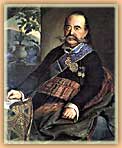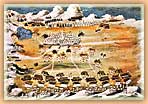 |

The escalating tension observed from the beginning of January 1821
reached its peak in the last ten days of March, when war was declared in Gortynia, Kalavryta, Patra, Mani, Kalamata, Gastouni, Bostitsa (Aigio)
and revolutionary agitation spread to almost all the whole of the Morea peninsula. The incidents developed in a similar way. The notables and the bishops of these areas gave up their reservations, often pressed by their local adversaries (for example the Mavromichalaioi by the Tzanetakides), took on the leadership of the armed men and declared the Revolution in their region. Flags dominated by the cross rather than the phoenix, the symbol of the Philiki Etaireia, were made, requests for weapons and proclamations were issued, while there was a first attempt at elementary regional organization with the objective of directing the revolt (Achaean Government, Messenian Senate). One of the most notable incidents of the first days
was the Maniates' taking of Kalamata and the proclamation issued there on 23 March by Petrobeis Mavromichalis.
The Ottomans were taken by surprise and this created panic, which facilitated the spread of the uprising. Alarmed and upset by the absence of major Ottoman forces, the Muslim population found refuge in the many strongholds of the Peloponnese dating to the period of Venetian occupation (1685-1715), and especially in Tripolitza (Tripolis),
a fortified town which was the Ottoman administrative and military centre in the Peloponnese. At the same time, the first groups of revolutionaries recruited armed men and were laying siege to forts (Methoni, Koroni, Neokastro/Pylos, Chlomoutsi/Gastouni, Akrokorinthos, Nauplion, Monemvasia).
In the first two months there were many problems and there were practically no successful operations. The preparations for the uprising were inadequate and the sieges were conducted by armed men who were armed only in name, that is, without canons and sufficient munitions. Few men were equipped with weapons other than knives and agricultural tools, and even fewer knew how to fight. Thus, when the Ottomans came out to seek provisions, the besiegers fled and their force dissolved. The farmers, who had no experience of armed conflict or siege warfare, needed time to train. The war with Ali Pasha of Ioannina which occupied a large part of the Ottoman forces offered the Peloponnesians the opportunity to form a force of armed men in good fighting condition.
At that time it was only the Maniates, the kapoi and the old klephts such as the Kolokotronaioi and the Plapoutaioi who had able armed men. Kolokotronis' famous phrase "Fire and axe to the submitted" proved to be an efficient antidote in overcoming the fear the Ottomans inspired and for the regrouping of the revolutionary troops.
Fear was gradually overcome and the first victories in the battlefields, at Valtetsi and Doliana in the middle of May 1821, proved to everyone that the Ottomans were not invincible.
From the summer the revolutionary efforts focused on the siege of Tripolitza. The occupation of the administrative and military
centre of the Ottomans was essential to the consolidation of the Revolution in the Peloponnese. The siege of Tripolitza involved more than twenty thousand civilian Muslims and many thousands of armed men and lasted many months, until the last days of September. Especially in the last month, when the pincer movement was getting intolerable and the provisions of the town had finished, many Christians went over to the Greek camp anticipating the sharing out of the spoils after the occupation of the town. The fall of
Tripolitza was followed by atrocities. Thousands of Ottomans, most of whom were non-combatants, as well as the Jews were massacred over three days. These events showed that there was no ground for reconciliation with the Ottoman power. The main slogan of the Revolution, Freedom or Death, now acquired a different character, and a more powerful base.
|


 |